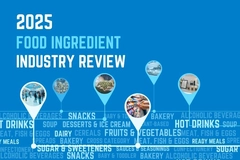
- Industry news
Industry news
- Category news
Category news
- Reports
- Key trends
- Multimedia
- Journal
- Events
- Suppliers
- Home
- Industry news
Industry news
- Category news
Category news
- Reports
- Key trends
- Multimedia
- Events
- Suppliers
Fermentation, flexibility and function: The next chapter for alternative proteins

As demand for high-protein fortified and clean label foods continues to grow, the alternative protein sector is entering a new phase. Plant-based products remain the dominant trend in this segment, but recent advances in fermentation-derived proteins, hybrid formulations, and functionality-focused ingredients are opening new markets — and posing new formulation and regulatory challenges.
Industry stakeholders are now looking beyond novelty NPD and focusing instead on ingredient precision, supply resilience, and sensory quality.
We speak with Lallemand, Biospringer, and ADM about how the industry is adapting to evolving consumer demands for alternate protein sources and the challenges these demands are creating for the market worldwide.

From novelty to necessity
Protein fortification began as a niche segment aimed at vegetarians but has matured into a key growth area for major F&B companies. “We have seen a significant increase in demand for protein-enriched products, driven by growing consumer interest in health, wellness, and sustainable nutrition,” says a Biospringer spokesperson.
“Across categories, there is a clear appetite for products that deliver additional protein, whether from plant, animal, or alternative sources such as yeast-based ingredients.”
 Silvia Soragni, category manager for Savory Ingredients at Lallemand.This shift reflects a broader trend in consumer behavior toward functional foods. Innova Market Insights data indicates that 40% of consumers globally have increased their protein intake, driving innovation in alternative proteins. NPD in this space grew by 4% between April 2020 and March 2025.
Silvia Soragni, category manager for Savory Ingredients at Lallemand.This shift reflects a broader trend in consumer behavior toward functional foods. Innova Market Insights data indicates that 40% of consumers globally have increased their protein intake, driving innovation in alternative proteins. NPD in this space grew by 4% between April 2020 and March 2025.
Nearly half of all global alternative protein launches were in Europe, with bakery and bread products leading globally, according to the global market researcher.
Functional diversification
Meeting and expanding consumer demands is a question of increasing quality and applicability, rather than quantity, the experts say. ADM emphasizes the importance of diversity and blendability in protein sources. “Each of our plant proteins and wholesome, plant-based ingredients is excellent when used individually or in combination,” says Jacquelyn Rodenkirch-Schuh, the company’s global senior director.
“In blends, our solutions bring forth innovation possibilities, taking the best characteristics from each source.”
Notably, soy and pea remain core components due to the company’s sensory profile and high protein scores — with soy achieving a PDCAAS (Protein Digestibility-Corrected Amino Acid Score, a method for evaluating the quality of protein in foods) of 1, making it a rare complete non-animal protein.
Lallemand Bio-Ingredients uses Engevita HiPRO Beyond — a non-GMO yeast-derived protein known for its sensory neutrality and nutritional completeness.
Unlike functional proteins, Engevita HiPRO Beyond offers no gelling, thickening, or foaming properties. “Its clean sensory profile allows easy integration into complex product matrices without the need for masking agents,” explains Silvia Soragni, Lallemand’s category manager for Savory Ingredients. “This gives formulators more control and flexibility in product development.”
Addressing off-notes
Despite growing consumer openness to alternative proteins, taste and texture remain critical barriers to wider adoption. Biospringer says this is a persistent issue, especially for yeast-derived ingredients and some plant proteins. “The challenge is also to be innovative in the provision of alternative protein sources without unwanted taste,” the company notes.
To address this, the company offers the Springer Mask range, a line of compounds designed to neutralize undesirable flavors while preserving protein functionality.
ADM is also investing heavily in new sensory tools. Its flavor and texture platforms rebuild richness and body in plant-based systems, while supporting low-sodium and clean label applications. “Consumers expect authentic sensory experiences, and we support that through both ingredient innovation and flavor science,” says Rodenkirch-Schuh.
Fermentation and precision as enabling platforms
 Protein fortification has grown from a niche segment to a core growth area for the industry.Fermentation continues to grow as a fundamental aspect of alternative protein development — both in terms of ingredient production and sustainability. Lallemand’s Engevita HiPRO Beyond is produced through fermentation using molasses, a by-product from sugar production. The process requires lower land and water use, avoids crop-related contaminants, and yields a protein that meets both clean label and digestibility targets.
Protein fortification has grown from a niche segment to a core growth area for the industry.Fermentation continues to grow as a fundamental aspect of alternative protein development — both in terms of ingredient production and sustainability. Lallemand’s Engevita HiPRO Beyond is produced through fermentation using molasses, a by-product from sugar production. The process requires lower land and water use, avoids crop-related contaminants, and yields a protein that meets both clean label and digestibility targets.
“Its clean sensory characteristics allow seamless incorporation into a wide range of products — from non-dairy beverages and hybrid cheeses to meat alternatives, sweet bars, and meal centers — without the need for masking agents or complex flavor systems,” says Soragni.
“Consumer familiarity with yeast as a food ingredient (e.g., in bread, beer, and wine production) supports broader acceptance of Engevita HiPRO Beyond. Additionally, the fact that it is produced through fermentation — a process widely associated with health and wellness — further reinforces its appeal, especially among sustainability-conscious and health-oriented consumers.”
ADM and Biospringer also point to the potential of precision fermentation and cultivated technologies. “These novel production methods have the potential to expand the range of protein sources by offering more sustainable and ethical alternatives,” Biospringer says.
Last year, Lallemand acquired Evolva, enhancing its capacity in precision biotechnology and upcycled ingredient development. The company says these technologies are core to the future of its protein portfolio.
Scaling strategically and regionally
Scalability remains a central problem in the alternative protein sector. “The cost of scaling up production from lab to industrial levels can be prohibitive,” Biospringer states.
ADM addresses this by leveraging regional manufacturing networks in North America, Europe, and Latin America. Its facility in Serbia, for instance, sources non-GMO soy within a 100-kilometer radius, helping to reduce transport and meet traceability requirements.
Strategic partnerships also play a critical role. Lallemand recently signed a North American distribution agreement with European start-up Revyve, whose Vitality-PG protein delivers functional benefits like emulsification and gelling — complementing Engevita’s nutritional focus and expanding the company’s range of clean label tools.
ADM, meanwhile, points to its global network of innovation centers and customer-facing workshops as essential to accelerating both R&D and market adoption.
The blended future of protein
Hybrid and blended protein strategies are also gaining momentum as manufacturers try to bridge traditional consumer demands. “These combinations offer an option that’s not an all-or-nothing approach compared to 100% plant-based or 100% animal-based,” Rodenkirch-Schuh explains.
Blended formats are also designed to create space for incorporating novel proteins, including those derived from fermentation or upcycled by-products, while maintaining traditional cost, taste, and nutritional benchmarks.
“Integrating next-generation proteins into blended formulas can improve their nutritional quality, taste, and scalability, which can make alternative proteins more affordable and widely available. Ongoing investment in technology for flavor modulation and texture enhancement is crucial to creating next-generation products,” Rodenkirch-Schuh continues.
“The evolution of hybrid and blended proteins — including those incorporating plant-plus-animal, emerging plant-based sources like quinoa and pulses, as well as plant-plus-fermentation-based combinations — is expected to further redefine the alternative protein landscape and offer consumers a diverse range of options.”
Lallemand emphasizes that whether protein is derived from soy, pea, yeast, or microbes, alternative sources and product designs will need to balance performance with transparency, and innovation with trust.
“Fermentation, precision biotechnology, and upcycling are all key pillars in shaping the future of sustainable food systems,” Soragni concludes










